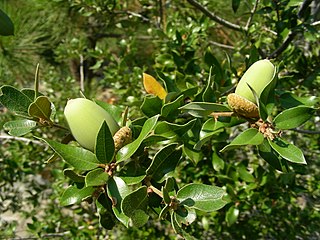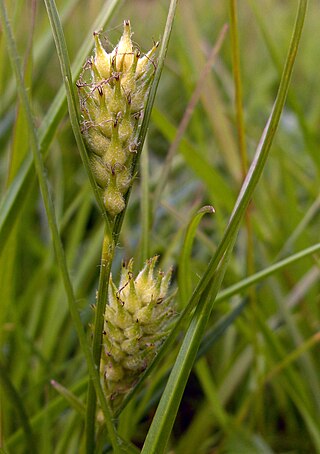
Chrysolepis is a small genus of plants in the family Fagaceae, endemic to the western United States. Its two species have the common name chinquapin. The genus occurs from western Washington south to the Transverse Ranges in Southern California, and east into Nevada.

Castanopsis, commonly called chinquapin or chinkapin, is a genus of evergreen trees belonging to the beech family, Fagaceae. The genus contains about 140 species, which are today restricted to tropical and subtropical eastern Asia. A total of 58 species are native to China, with 30 endemic; the other species occur further south, through Indochina to Indonesia and the Philippines, mountainous areas of Taiwan, and also in Japan. The English name chinkapin is shared with other related plants, including the golden chinkapins of the Pacific United States, which are sometimes included within Castanopsis but are more often considered a separate but very closely related genus, Chrysolepis.

Ornamental grasses are grasses grown as ornamental plants. Ornamental grasses are popular in many colder hardiness zones for their resilience to cold temperatures and aesthetic value throughout fall and winter seasons.

California mixed evergreen forest is a plant community found in the mountain ranges of California and southwestern Oregon.

Carex is a vast genus of over 2,000 species of grass-like plants in the family Cyperaceae, commonly known as sedges. Other members of the family Cyperaceae are also called sedges, however those of genus Carex may be called true sedges, and it is the most species-rich genus in the family. The study of Carex is known as caricology.

Quercus chrysolepis, commonly termed canyon live oak, canyon oak, golden cup oak or maul oak, is a North American species of evergreen oak that is found in Mexico and in the western United States, notably in the California Coast Ranges. This tree is often found near creeks and drainage swales growing in moist cool microhabitats. Its leaves are a glossy dark green on the upper surface with prominent spines; a further identification arises from the leaves of canyon live oak being geometrically flat.
Chrysolepis is a genus of prehistoric marine lobe-finned fish that lived during the Late Devonian period. It contains a single species, C. orlensis, known from the middle Famennian of Oryol Oblast, Russia. It is the only member of the family Chrysolepididae, erected due to its highly distinct morphology unseen among other osteolepiforms. It may be the sister taxon to the eusthenopterids.
The Mediterranean California lower montane black oak–conifer forest is a major forest association and ecosystem of the California mixed evergreen forest bioregion in certain mountain ranges in California and southern Oregon in the Western United States; and Baja California in northwest Mexico.

Carex riparia, the greater pond sedge, is a species of sedge found across Europe and Asia. It grows in a variety of wet habitats, and can be a dominant species in some swamps. It is Britain's largest Carex, growing up to 130 cm tall, with glaucous leaves up to 160 cm long. It hybridises with a number of other Carex species, including the closely related Carex acutiformis – the lesser pond sedge. A variegated cultivar is grown as an ornamental grass.

Carex hirta, the hairy sedge or hammer sedge, is a species of sedge native across Europe. It has characteristic hairy leaves and inflorescences, and is the type species of the genus Carex.

Chrysolepis chrysophylla is a species of flowering shrub or tree in the beech family known by the common names golden chinquapin, giant chinquapin, and western chinquapin. It is native to the Pacific coast of the United States.
Rectiostoma fernaldella is a species of moth in the family Depressariidae. It was described by Riley in 1889. It is found from southern Mexico to the United States, where it is found in the eastern basin and range area in southern Arizona and disjunctly to California. There is also a record for Tennessee.

Anolis planiceps, commonly known as the golden-scaled anole, orange-fanned leaf-litter anole, or goldenscale anole, is a species of lizard in the family Dactyloidae. The species is found in Venezuela, Guyana, Brazil, and Trinidad.

Carex sect. Ovales is a section of the genus Carex, containing around 85 species of sedge. It is the most diverse section of the genus in North America, containing 72 species:

Carex subg. Carex is a subgenus of the sedge genus Carex. It is the largest of the four traditionally recognised subgenera, containing around 1400 of the 2000 species in the genus. Its members are characterised by the presence of one or more exclusively male (staminate) terminal spikes, quite dissimilar in appearance from the lateral female (pistillate) spikes below. In most species, the female flowers have three stigmas, but a few species, including Carex nigra, have female flowers with only two stigmas.

Carex subg. Vignea is a subgenus of the sedge genus Carex, containing around 300 of the 2000 species in the genus. Its members are characterised by having bisexual, sessile spikes, where the female flowers have two stigmas each.

Anolis chrysolepis, the goldenscale anole, is a species of lizard in the family Dactyloidae. The species is found in Guyana, Suriname, French Guiana, and Brazil.













